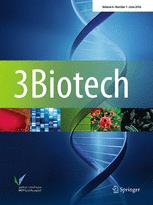Ver ítem
- xmlui.general.dspace_homeCentros e Institutos de InvestigaciónCICVyA. Centro de Investigación en Ciencias Veterinarias y AgronómicasInstituto de BiotecnologíaArtículos científicosxmlui.ArtifactBrowser.ItemViewer.trail
- Inicio
- Centros e Institutos de Investigación
- CICVyA. Centro de Investigación en Ciencias Veterinarias y Agronómicas
- Instituto de Biotecnología
- Artículos científicos
- Ver ítem
Recombinant occlusion bodies of baculovirus as carriers of a nonstructural protein of foot-and-mouth disease virus
Resumen
Here, we developed a diagnostic ELISA for foot-and-mouth disease using recombinant occlusion bodies (rOBs) of baculovirus. We fused Δ3AB1–3, a polypeptide derived from non-structural proteins of foot-and-mouth disease virus, to polyhedrin (POLH), the major constituent of OBs, under polh promoter. To further assess the most convenient strategy to improve yields, we designed two recombinant baculoviruses, vPOLH and vPOLHE44G. These carried the sequence of
[ver mas...]
Here, we developed a diagnostic ELISA for foot-and-mouth disease using recombinant occlusion bodies (rOBs) of baculovirus. We fused Δ3AB1–3, a polypeptide derived from non-structural proteins of foot-and-mouth disease virus, to polyhedrin (POLH), the major constituent of OBs, under polh promoter. To further assess the most convenient strategy to improve yields, we designed two recombinant baculoviruses, vPOLH and vPOLHE44G. These carried the sequence of the fusion protein POLH-Δ3AB1–3 with an additional copy in cis of polh or polhE44G, respectively, under p10 promoter. Our results show that both viruses expressed POLH-Δ3AB1–3, which was detected by western blot in purified rOBs with anti-POLH and anti-3AB1 antibodies. We also found that vPOLHE44G produced larger polyhedra and a significant increase of antigen yield (p < 0.01). Furthermore, the chimeric protein POLH-Δ3AB1–3 was recognized by sera from experimentally infected animals, showing that translational fusion to POLH does not alter the antigenicity of Δ3AB1–3. Finally, the rOBs were successfully used in an ELISA test to differentiate infected from vaccinated animals. Taken together, these results demonstrate the great potential of rOBs to develop diagnostic schemes adaptable to animal infectious diseases.
[Cerrar]

Autor
Fuente
3 Biotech 8 : 457. (November 2018)
Fecha
2018-11
Editorial
Springer
ISSN
2190-572X
2190-5738 (Online)
2190-5738 (Online)
Formato
pdf
Tipo de documento
artículo
Palabras Claves
Derechos de acceso
Restringido
 Excepto donde se diga explicitamente, este item se publica bajo la siguiente descripción: Creative Commons Attribution-NonCommercial-ShareAlike 2.5 Unported (CC BY-NC-SA 2.5)
Excepto donde se diga explicitamente, este item se publica bajo la siguiente descripción: Creative Commons Attribution-NonCommercial-ShareAlike 2.5 Unported (CC BY-NC-SA 2.5)

